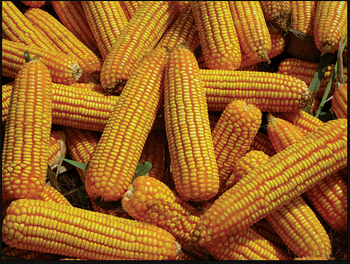
As corn planting time nears, Mississippi growers are wondering if they’ll face a third year in a row of cold, wet weather and possible delays getting seed into the ground.
Although 2013 and 2014 saw rocky starts, growers ended up harvesting record corn yields both years — 180 bushels and 186 bushels, respectively.

ERICK LARSON
Could those yields have been better? Possibly, says Erick Larson, associate Extension and research professor of plant and soil sciences at Mississippi State University.
By fine-tuning irrigation to avoid saturated soils and managing fertilizer applications to minimize losses during critical growth stages, producers may be able to offset some of the weather adversities Mother Nature tosses at them, he said at the annual meeting of the Mississippi Agricultural Consultants Association.
Stay current on what’s happening in Mid-South agriculture: Subscribe to Delta Farm Press Daily.
“A big limitation in 2014 was a lot of rainfall and a lot of cloudy weather, particularly during the period when lot of corn was tasseling or in the early reproductive stages,” he says.
“Especially in the central Delta, extending northward, growers had to contend with a tremendous amount of rainfall. Yet, strangely, at the tail end of the rains, we started getting phone calls from growers asking ‘Why is my corn wilting?’ Even in our research plots, corn would look fine in the morning and later in the day would start wilting badly.”
Wilting, Larson says, is not always a reliable indicator of a shortage of soil moisture deficit. “Last year, probably the biggest cause was poor aeration and physiological stunting from saturated soil conditions.”
Some 75 percent of corn root development is during late vegetative stages, he notes. “From an irrigation management standpoint, what you want to do is try and meet the crop’s water demand, but not overwater and saturate the soil. You don’t want to limit the plant’s potential to develop roots, because those roots are going to be very important in providing plants the resources they need to produce high yields later in the growing season.”
Understanding corn's water needs
The goal, Larson says, is to try and match corn’s water needs to its various growth stages.
“Corn is a lot more sensitive to stress during tasseling and early reproductive stages. In the past, much of our irrigation scheduling has been a flatline approach — apply irrigation every Monday if it doesn’t rain. There is a lot of opportunity to better manage irrigation scheduling.”

"The goal," Larson says, "is to try and match corn’s water needs to its various growth stages."
Corn’s water needs during the growing season can be represented by a parabolic, bell-shaped curve, he says. “Understanding how corn’s water needs and crop response to stress vary during the season can greatly reduce expense and improve profit, if you are willing to vary your irrigation schedule relative to those different periods. Using soil moisture sensors to determine soil moisture reserves are another critical component that can help growers to apply water in a manner to get the most bang for the buck and improve crop productivity.”
During intermediate vegetative stages, from V6 until V12, soil water deficit will only cause minor yield reduction, if any, Larson says. “During this period, we generally have good soil moisture reserves, so risk associated with water deficit is low and quite rare in Mississippi.”
In 2014, abundant June rainfall hurt corn productivity in many areas, limiting plant height and stunting the corn. These issues were sometimes compounded by irrigation preceding this rainy period, particularly on heavy soils. “There can be negative consequences associated with soil saturated during this period, and it’s something we want to try and avoid,” he says.

CHECK OUT this reader favorite photo gallery of legendary combine driver Jesse Small.
“Things change significantly as corn enters the early reproductive stage and tasseling, when it becomes extremely sensitive to stress. We want to use a much different philosophy of irrigation scheduling during this time to make sure we alleviate any moisture deficit.”
As corn goes through the reproductive stages, sensitivity to water stress subsides, particularly during the last two or three weeks prior to physiological maturity, Larson says. “But some growers cut water off too early, while others water too late in the season. There is also great opportunity at this time of year for more careful water management.”
In years of a lot of rainfall during the growing season, a second issue compounded by soil saturation is nitrogen deficiency. “Nitrogen is a major component of the corn production budget,” he says, “so it’s very important to get the maximum benefit from this input.
“There are a number of issues with nitrogen in the South, where we have very warm, wet conditions, and a long growing season. This can result in nitrogen losses, particularly from denitrification, leaching, and volatility. When soils are saturated, denitrification and leaching are the two biggest types of losses.”
To manage nitrogen optimally, Larson says, “We need to look at nitrogen uptake during the different periods of the growing season and break it down according to the crop’s needs.
Timing of nitrogen applications
In the first 30 days, until corn enters rapid growth stages, it uses less than 10 percent of seasonal nitrogen. “We do need to apply some nitrogen during this time period,” he says. “In the last two years, when we had a tremendous amount of rainfall in April, some growers experienced nitrogen application timing difficulties.

â��€œWe need to look at nitrogen uptake during the different periods of the growing season and break it down according to the crop’s needs." — Erick Larson
“I would like to have some nitrogen applied by the time corn gets to the V3 growth stage, generally about two weeks after emergence. I’d recommend applying 15 percent to 25 percent of seasonal nitrogen to carry the crop along in case your sidedress application is delayed. I certainly would apply no more than 25 percent during this early time period to reduce the potential for wet conditions to cause nitrogen loss.”
As corn enters its rapid growth stages, Larson says, “it uses the bulk of seasonal nitrogen very fast. I like to apply the sidedress nitrogen application at the onset of these rapid growth stages, at V6, or a bit before.”
In the later growth stages, he says, corn doesn’t need a lot of nitrogen. “But it needs it for a fairly long time, 45 to 50 days, to carry it to the end of the growing season. I’d like to see more pre-tassel applications in order to maintain nitrogen to the end of the growing season.”
Typically, when there is a nitrogen deficiency not caused by catastrophic losses, Larson says, it will be during the last 30 days or so.
“If the crop is healthy, timing of the pre-tassel application doesn’t matter a lot, he says. “All you’re trying to do is split your application and maintain enough nitrogen to get the corn to the end of the growing season.
“In terms of the appropriate timing for the tassel shot, the first thing I would do is analyze the crop condition: Is the corn healthy? Are you making the application to maintain and improve overall nitrogen efficiency? Or have you had a lot of nitrogen losses, associated with soil being saturated over a long period, and you’re trying to compensate for losses you know are pretty extreme? In that case, you need to correct the situation as soon as possible, but if the soil is saturated, just applying nitrogen is not going to instantaneously overcome the situation. The soil needs to dry out first.”
For the most part, Larson says, growers are doing a good job of managing nitrogen, “but they might consider increasing the amount of nitrogen applied for the later growth stages, while minimizing it during the early growth period. This management method would reduce exposure of nitrogen to the elements and maintain availability to the crop throughout the growing season.”
About the Author(s)
You May Also Like




